The Video Spectral Comparator (VSC) is a UV-Vis-IR imaging spectral device designed for forensic examination and authentication of questioned documents. It was developed by Foster and Freeman. A basic VSC unit consists of a high-sensitivity camera, different light sources, a software/viewing interface, and a positioning stage.
The built-in multiple spectrum sources can reveal hidden characteristics that can’t be visible to human eyes. Law enforcement and legal experts use VSC to check if documents like passports, IDs, or contracts are real or fake.
History and Development of Video Spectral Comparator
The Video Spectral Comparator (VSC) is the pioneering work of Foster and Freeman, a company specializing in forensic science tools like ESDA.
Year of Introduction: The first model was introduced in the late 20th century. This model had only basic UV and IR light sources.
Evolution and Development
In the past few decades, there have been significant advancements, both in terms of hardware and software capabilities of the Video Spectral Comparator. The following table represents the development of various models.
| Model | Year Introduced | Notable Features |
|---|---|---|
| VSC-1 | Late 1990s | Basic UV and IR capabilities |
| VSC-2000 | Late 1990s | Introduction of microspectrophotometer with color space and software |
| VSC 40 | Early 2000s | Compact with nearly all features of VSC 2000 |
| VSC 6000 | Mid-2000s | Enhanced resolution, added filters |
| VSC 80 | Late 2010s | For fast imaging mainly used by immigration/security departments |
| VSC 800 | Late 2010s | Mid-Range High-Resolution Video Spectral Comparator |
| VSC8000 | Late 2010s | High-resolution imaging, software integration |
A. Hardware Improvements:
- Earlier models had limited spectral range (usually UV and IR) and imaging capabilities.
- Modern versions now include high-resolution cameras (12 MP) and a broader range of light sources.
B. Software Advancements:
- Equipped with sophisticated software for automated examinations.
- VSC8000 also featured automated image comparisons.
- Introduction of hyperspectral imaging.
- 3D document imaging and Optical Character Recognition (OCR)
- Casework management tool
Working Principle of VSC
The Video Spectral Comparator (VSC) operates on light and electromagnetic radiation principles.
In general, when light hits, there are numerous types of interaction that result in emitted wavelengths because of the composition of the object.
Types of Light Interactions With Documents in VSC
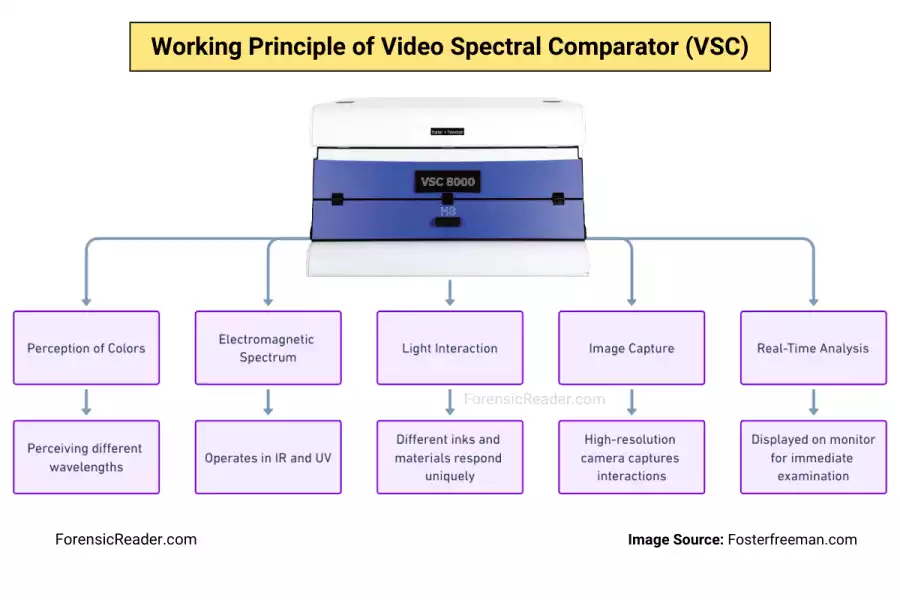
When light interacts with an object, it results in one of the following five things:
| Light Interactions | Description | Resulting Appearance |
|---|---|---|
| Reflection | Object reflects all or part of the light. | Appear white or lighter. |
| Absorption | The object absorbs all or most of the light. | Appear black or darker. |
| Reflection and Absorption | A combination of both reflection and absorption. | Produces colors in the desired spectrum. |
| Transmission | Light can pass through the object. | Depends on the object’s material. |
| Luminescence | Light strikes the object, is absorbed, and then re-emitted. | Re-emitted at a longer wavelength. |
Basic Working Mechanism of VSC
- Perception of Colors: When the human eye sees different colors, it is actually perceiving different wavelengths of light.
- Electromagnetic Spectrum: VSC operates not just in the visible spectrum but also in the Infrared (IR) and Ultraviolet (UV) regions, which are not visible to humans.
- Light Interaction: When light interacts with the document, different inks and materials respond uniquely.
- Image Capture: A high-resolution camera captures these interactions.
- Real-Time Analysis: The captured image is displayed on a monitor, allowing for immediate examination.
Parts of Video Spectral Comparator (VSC)
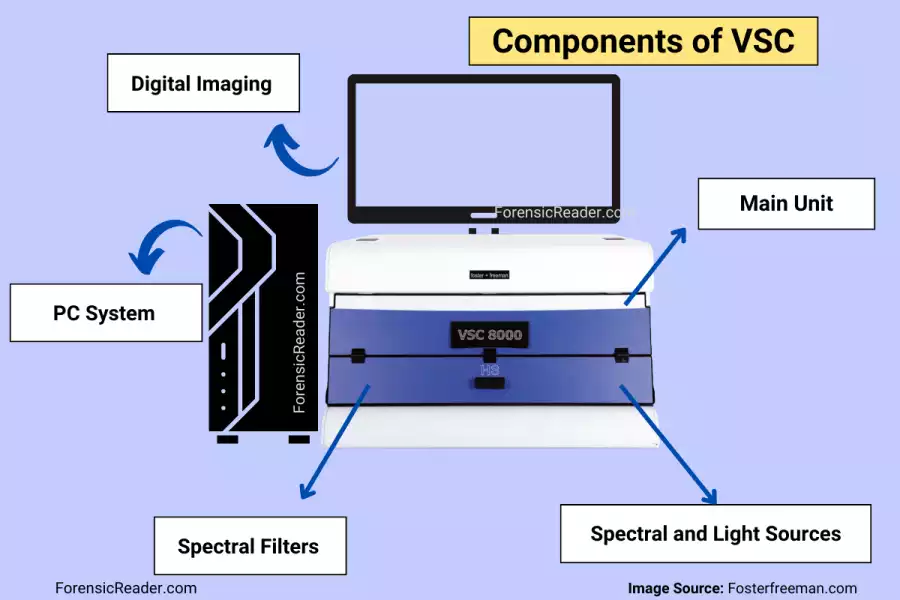
A typical VSC box contains consist of five major parts and components:
- Main Unit
- Spectral and Light Sources
- Spectral Filters
- Digital Imaging, Magnification, and Hyperspectral Imaging
- PC System
1. Main Unit
The Main Unit of a VSC is a square box that houses the core components including a high-resolution CCD camera, different light sources, and optical filters.
- Camera: The high-resolution camera with a sensitivity from 360 nm to 1100 nm.
- Light Sources: Range from ultraviolet to infrared.
- Optical Filters: To isolate specific wavelengths of light thus enhancing the ability to detect minute details in a questioned document.
2. Spectral and Light Sources
The VSC employs four distinct types of light sources. These are:
A. Incandescent Filament Lamps
B. LED Lamps
C. UV Lamps (Vapour Discharge Tubes)
D. Flash Tube
A. Incandescent Filament Lamps:
- Range: Visible and IR light.
- Applications: Used for flood, transmitted, spot, and side lighting.
- Flood Lighting: Broadband illumination.
- Spot Lighting: High-intensity illumination, directly above the document platen.
B. LED Lamps:
- Wavelength: Variable wavelength range mainly visible.
- Applications: Used with coaxial and diffracted lighting.
- Coaxial Lighting: Shone perpendicularly on the document to reveal retro-reflective features.
- Diffracted Lighting: Illuminates the document from different directions, usually used to see Optically Variable Devices/Inks (OVD).
C. UV Lamps (Vapour Discharge Tubes):
- Ranges: UV-A, UV-B, and UV-C peak wavelengths.
- UV-A: 320 to 400 nm
- UV-B: 280 to 320 nm
- UV-C: 200 to 280 nm
- Applications: Illuminate the document and transmitted lighting offers analysis of watermarks, ink differentiation, paper examination, counterfeit detection, etc.
D. Flash Tube:
- Range: Specific range but at a broad spectrum from visible to IR.
- Applications: Used for the Anti-Stokes flash function.
- Anti-Stokes Flash: Uses narrow-band illumination (primarily above the IR region) to excite fluorescence.
| Light Source | Range/Wavelength | Key Applications |
|---|---|---|
| Incandescent Filament Lamps | Visible and IR | Flood, Transmitted, Spot, Side Lighting |
| LED Lamps | Specific Wavelength in Visible | Coaxial, Diffracted Lighting |
| UV Lamps | UV-A, UV-B, UV-C | General and Transmitted UV Lighting |
| Flash Tube | Broad spectrum | Anti-Stokes Flash |
3. Spectral Filters
Modern VSCs can analyze wavelengths from ultraviolet (200–400 nm) to infrared (700–1000 nm) and special filters isolate these wavelengths. Majorly spectral filters are used along with a camera with a specific cutoff frequency.
The following table represents some of the filters (not bound to every VSC unit) to isolate and invade higher spectral analysis.
| Type of Filter | Function | Common Applications | Typical Wavelength Range (nm) |
|---|---|---|---|
| Bandpass Filters | Allows a specific range of wavelengths to pass through. | Isolating particular spectral features. | 400-700 |
| Longpass Filters | Allows all wavelengths above a certain threshold to pass through. | Blocking shorter wavelengths. | > 700 |
| Short pass Filters | Allows all wavelengths below a certain threshold to pass through. | Blocking longer wavelengths. | < 400 |
| Polarizing Filters | Allows light of a specific polarization to pass through. | Revealing hidden information. | N/A |
| Neutral Density Filters | Reduces the intensity of all wavelengths of light equally. | Controlling camera exposure. | N/A |
| Color Filters | Allows only certain colors (and their corresponding wavelengths) to pass through. | Differentiating inks of similar appearance. | Varies |
| Infrared (IR) Filters | Specifically designed to allow only infrared light to pass through. | Capturing features not visible in regular spectrum. | 700-1000 |
| Ultraviolet (UV) Filters | Allows only ultraviolet light to pass through. | Revealing watermarks or fluorescent security threads. | 200-400 |
4. Digital Imaging, Magnification, and Hyperspectral Imaging
A. Digital Imaging
The Digital Imaging component is a high-resolution, scientific-grade digital camera that captures images for analysis.
- Resolution: The camera typically has a high pixel count. The latest VSC8000/HS has a 12MP camera.
- Also offers Super Resolution Imaging (SRI) up to 127MP.
- 15 Modes of advanced UV-Vis-IR imaging
- Real-Time Analysis: Displayed image on a monitor, allowing for real-time examination.
B. Magnification and Zoom Range
It allows for the close examination of fine details on a document.
- Earlier VSC’s model had a zoom range from approximately x1.5 to x170. The latest model offers up to 250x magnification.
- Zoom Control: Usually controlled both manually and via the software.
C. Hyperspectral Imaging in VSC
Hyperspectral Imaging was recently introduced in VSC8000 models. It is highly effective in a forensic examination where there are spectral differences in inks, toners, and pigments.
The working methodology of Hyperspectral Imaging is:
- Bandpass Filtered Light Source: Document examined under a light source filtered at progressively longer wavelengths.
- Data Cube Creation: A sequence of images is captured to create a hyperspectral datacube and dataset.
- Each image represents specific spatial and spectral information at a predetermined wavelength.
5. PC System
Modern VSCs are often integrated with a Windows-based PC system.
Software: VSC SUITE is the specialized software designed by Foster and Freeman® that gives the examiner a fluent quick-access toolbar.
System requirements to run VSC SUITE:
| Component | Specification |
|---|---|
| Operating System | Windows 8 or higher |
| Display | High-Resolution |
| RAM | 16GB or higher |
| Storage | SSD with at least 256GB of free space |
Step-by-Step Procedure of Using VSC for Document Examination
There are four major steps involved in the examination of the document via Video Spectral Comparator (VSC):
- Document Placement
- Light Source Selection
- Image Capture and Filters
- Software Features and Saving Data
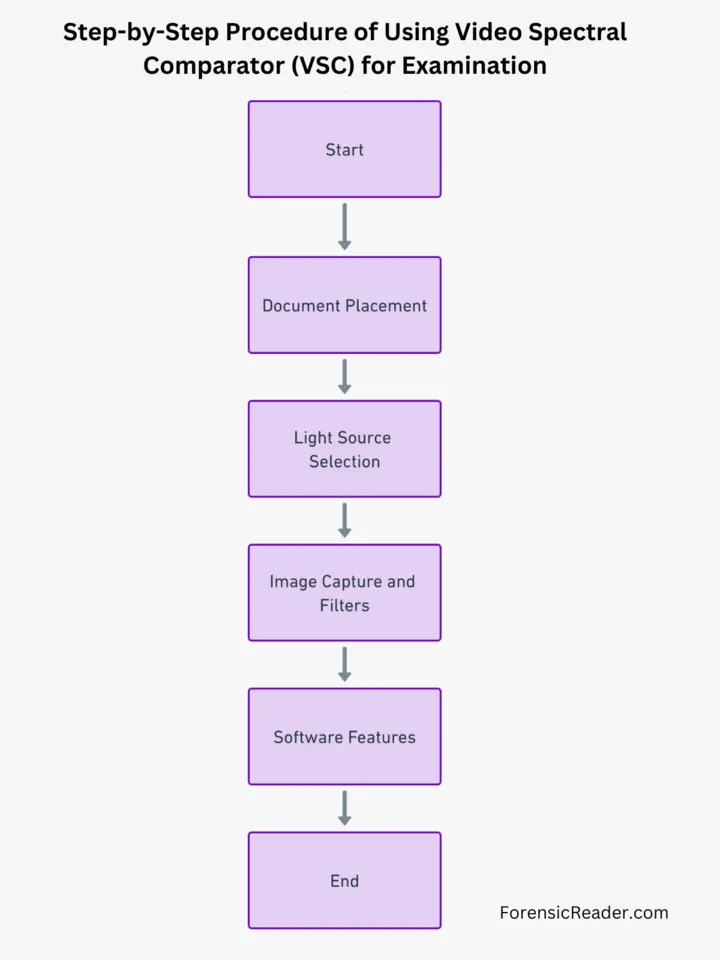
Step 1: Document Placement
Place the questioned document or banknote on the positioning platen, which is the flat surface designed to hold the document in place.
- Alignment: Ensure that the document is properly aligned and placed in the middle to capture the area of interest.
- Clamping: Some VSC models come with soft clamps to securely hold the document in place.
- Modern VSC8000/HS offers a motorized XY document positioning stage.
The following image represents the three test samples that needed to be examined under VSC for authentication.

Step 2: Light Source Selection
Choose an appropriate light source or wavelength range for examination. The choice depends on what you are looking to investigate such as ink differentiation, watermark verification, or other features.
- Types of Light: UV, visible, and IR are the primary types of light used.
- Mode: Light can be incident onto the document or transmitted through the document.
Note: If you want to do full spectral analysis, you should choose the “Hyperspectral Imaging” function using the VSC suite.
Example 1: Examination of Different Ink used in forged Signature
Example 1A: Examination of questioned documents under 400 to 570 nm and the reflected IR light reaching the camera passing through a filter with a cutoff frequency of 610 nm.

Example 1B: Examination of QD under 450 to 600 nm and the cutoff frequency of the camera filter at 630 nm.
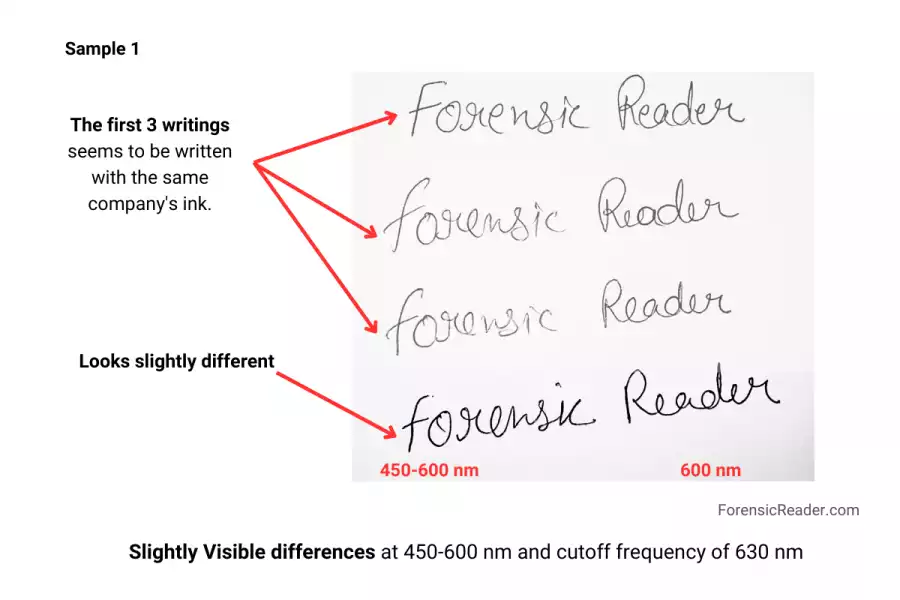
Example 1C: Examination of QD under 650 to 700 nm and the cutoff frequency of the camera filter at 750 nm.
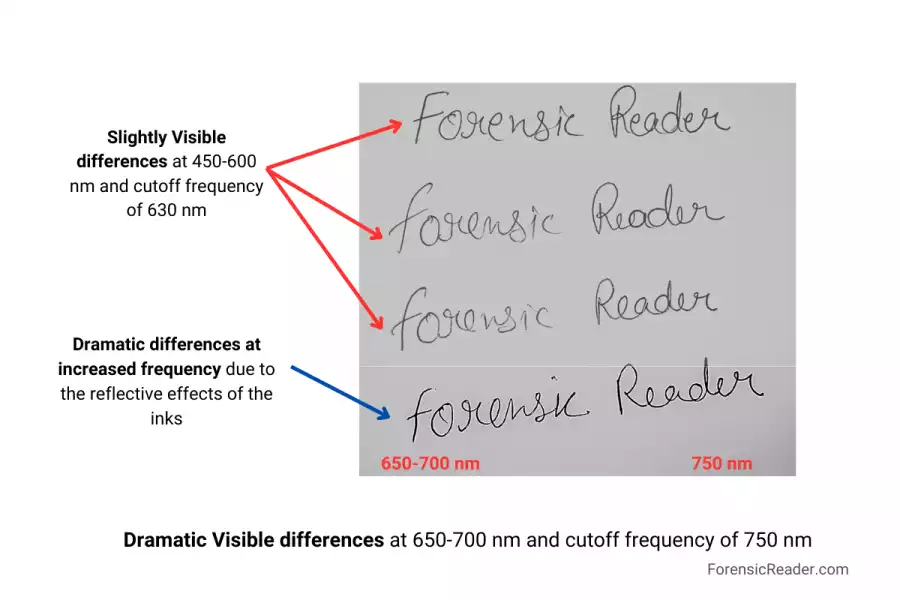
Example 2: Examination of Suspected Addition and Modification of Number in Cheque
The following Image represents a clear difference between the original and modified number in the cheque under IR of Video Spectral Comparator (VSC).

Example 3: Examination of Obliteration to Reveal Original Writing
The following image represents how obliterated marks with different pens can easily be differentiated under the IR light source of VSC.
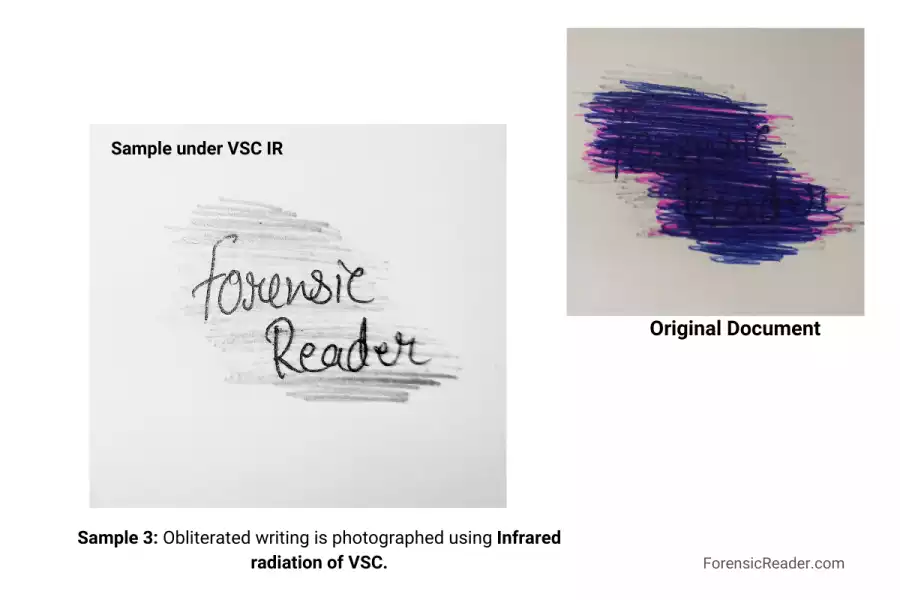
Note: In all examples, there are different companies’ inks/pens used for forgery which can easily be detected under VSC but if the same pen is used then it is very hard to detect such forgery.
Step 3: Image Capture and Filters
Camera Settings: Ensure the camera settings are adjusted for optimal image quality and set the cutoff frequency of the camera’s filters at a desired frequency.
Example of a typical setting:
- Light source: between 400 and 540 nm
- Reflected IR light reaching the camera passes through a filter with a cutoff frequency of 610 nm.
In the above example, here’s what each part means:
- “Reflected IR light reaching the camera”: This means that the camera is capturing the IR light that is reflected off the ink.
- “Passing through a filter with a cutoff frequency of 610 nm”: This specifies that the camera has an optical filter that allows light with wavelengths shorter than 610 nm to pass through to the camera sensor.
- In context a longpass filter with a cutoff wavelength of 610 nm: allows all wavelengths longer than 610 nm to pass through.
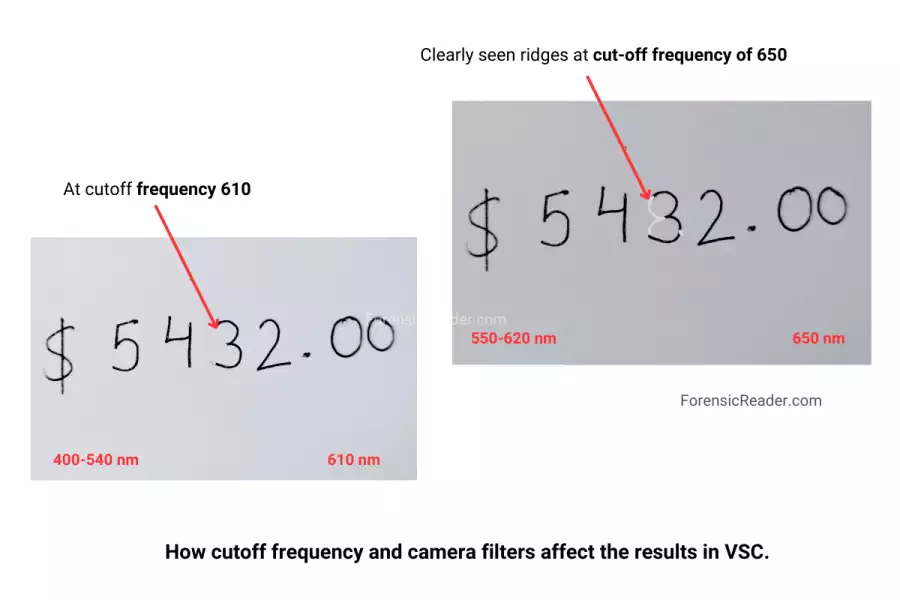
Step 4: Software Features and Saving Data
Modern VSC Suite is equipped with advanced software features that offer a range of functionalities beyond simple image capture.
- Image Processing: Enhance, filter, or otherwise modify the captured image for better clarity.
- Automated Routines:
- Image Enhancement: Improve image quality for better analysis
- Comparison: Side-by-side comparison of questioned and known samples
- Database Integration: Link to a database of known samples for quicker identification.
Applications of VSC
A. Forensic Use
- Forgery Detection: Can differentiate between original and copied signatures, altered dates, and amounts on financial documents.
- Ink Analysis: Different inks fluoresce differently under varied light conditions based on their spectral properties aiding alterations.
- Evidence Recovery: Recovering deteriorated documents due to fading or burning (charred documents).
- Reveal latent images, watermarks, and UV-activated security features.
- Reveal Obliterated Writing: For example, VSC IR light reveals the text beneath the obliteration of original content.
B. Immigration and Security
VSC technology is extensively used by Immigration, Border Control agencies, and other security agencies.
- Authentication: Verify the authenticity of security features like holograms, watermarks, and luminescent elements.
- Passport Verification: For example, a U.S. passport that is suspected to be counterfeit. Under VSC’s UV light, the passport fails to reveal the expected fluorescent patterns (a security feature of U.S. passports).
- Visa Verification: For example, under UV light, U.S. visas reveal the fluorescent seal of the U.S. Department of State and also microprinting indicating a genuine document.
C. Banks
- Security Features: This can reveal hidden or latent security features in banknotes, bonds, bills, and other important financial documents.
- Currency Monitoring: For example, a $100 U.S. dollar bill that is suspected to be counterfeit. Its VSC IR analysis reveals watermarks and security thread but under UV it fails to reveal a luminescent strip (should glow blue). Hence, the bill is a counterfeit.
- Cheque Verification: For example, in the examination of a cheque under the IR spectrum of the device, one ink appears darker than the other suggesting two different inks were used.
D. Art and Historical Artifact Analysis
- Painting Verification: Based on the spectral characteristics old pigments such as lapis lazuli can easily be differentiated from modern synthetic blue pigments.
- Analysis of Ink Makers: In the USA, manufacturers are advised to add specific markers/tags (Ink Library of the United States Secret Service) that have spectral properties of differentiation.
- Age of the documents: For example, a manuscript is claimed to be a 12th-century religious text. The manuscript is written with black ink (iron gall ink) but spectral data reveals that ink pigment is known as “Prussian blue” which was not synthesized until the 18th century. Hence, it was a fake document or replica.
E. Academic Research
- Material Science: For example, a textile sample claimed to be fire-resistant. Using the VSC’s IR light source, the textile shows even fire-resistant coating.
- Archaeological Research: Examination of ancient texts and artifacts. For example, an ancient clay with barely visible inscriptions was recovered. In VSC’s IR light source, its indentations become more visible, revealing details.
Advantages of VSC
- Not bound to Forensic Use: There are numerous applications, ranging from document verification to historical manuscript examination.
- Non-Destructive Examination: Being a non-destructive method of examination, it ensures that the original questioned document remains unaltered which is important in maintaining a chain of custody.
- High-resolution imaging System ensures that captured images can reveal subtle alterations or forgeries.
- Multiple Light Sources and Filters: One doesn’t need to buy separate UV or IR light torches. They all are equipped in one box and so are the filters.
- Quick Analysis: Offers a quick scan and analysis of documents, making them extremely efficient.
- Ease of Use: Modern VSCs have user-friendly interfaces that can easily be learned without knowing how they work. So, one can learn easily even for those with limited technical expertise.
- Software Features: Advanced software capabilities allow for a wide range of examinations and analyses in simple clicks.
- Automated Routines: Some models can perform a series of examinations automatically further speeding up the examination process.
- Database Integration: The ability to integrate with different databases.
- Compliance with Standards: Video spectral comparators are designed to meet or exceed international standards for forensic document examination.
Disadvantages of VSC
- Calibration: Require regular calibration to maintain accuracy.
- Maintenance: The sensitive components, such as light sources and filters, may require frequent maintenance.
- Software Misuse: Incorrect use of advanced software features can also compromise the integrity of the examination.
- High Initial Investment: VSCs can be expensive (cost thousands of dollars), making them less accessible for smaller organizations or individual experts.
- Training Needed: Often requires specialized training, which can be time-consuming and costly.
- Not Foolproof: While VSCs are highly accurate, they are not 100% foolproof. Some inks are spectral inactive and may sometimes fail to detect extremely sophisticated forgeries (or forgeries with the same inks).
- Power Consumption: Video spectral comparators in regular use can consume a lot of power, which may be a concern for long-term operational costs.
Precautions While Using Video Spectral Comparator
General Precautions
- User Training: Ensure that the operator is well-trained and understands the basic principles behind its functionality.
- Calibration: Regularly calibrate the VSC device to ensure accurate results. Use certified standards for calibration.
- Electrical Safety: Make sure the device is properly grounded to avoid electrical hazards.
- Software Updates: Make sure the VSC Suite is regularly updated along with Windows OS.
- Cleanliness: Keep the device and its components clean to avoid contamination of samples.
- Eye Protection: Always wear appropriate eye protection when using UV or high-intensity light sources.
Specific to VSC
- Wavelength Sensitivity: Be cautious when selecting the wavelength for examination. Incorrect selection can lead to false results.
- Ink Differentiation: When examining inks, be aware that similar-looking inks may have different spectral properties. Always run controls for comparison.
- Document Handling: Handle documents with care to avoid altering their physical or chemical properties, which could affect the examination. Use thick gloves to avoid fingerprints.
- Camera Setting and Filter Selection: Use the appropriate filters, camera settings, and cut-off frequency for specific examinations. Incorrect configuration could lead to misleading results.
- Data Storage: VSC’s Suite offers a data management tool to properly store images based on dates, case numbers, etc. This is important to maintain the chain of custody.
- Equipment Check: Regularly check the condition of light sources, filters, and other accessories for wear and tear.
- Environmental Conditions: Always operate it in a controlled environment to reduce the effects of humidity and temperature on analysis.
Video Spectral Comparator (VSC) Models and Examples
Different Models of VSCs offered by Foster and Freeman. Currently, there are two main models that are designed for forensic experts and other document examiners. These are VSC 8000/HS and VSC 80/FS.
Key Features of VSC 8000/HS
- High-Precision 12MP Camera: For observing covert security features and confirming document authenticity.
- Super Resolution Imaging (SRI): Provides excellent clarity and image resolution.
- Microspectrophotometer: Non-destructive spectral analysis of documents to identify differences in ink and paper formulations (additives, fillers, etc.).
- 250x Optical Magnification: For microscopic detail analysis of questioned documents.
- Automated Examinations: Increases the speed and efficiency of examinations.
- 3-Dimensional Imaging: For better analysis of security features, pen-tip strokes, indentations, and other impressions in paper.
Key Features of VSC 80
- High Sensitivity Camera: Full-HD images captured via a high-sensitivity, Vis-IR camera with a zoom lens.
- Magnification: Up to x80 magnification with no loss of image resolution.
- Removable Transmitted Light Base: Allows the examiner to inspect larger/thicker items.
- 3D Imaging Software Module: For inspection of signatures and handwriting.
- Optional Spectrometer Module: For real-time capture of various spectra.
- Embedded Data Decoders: Can detect and read 1D and 2D barcodes, ICAO encoded MRZ data, and embedded IPI and ICI.
- Optional e-Passport Readers: For capturing and reading RFID documents.
Major Differences Between VSC 8000/HS and VSC 80
- Magnification: VSC 8000/HS offers up to 250x optical magnification, while VSC 80 offers up to 100x magnification.
- Software: VSC 8000/HS has a more intelligent software interface with automated examinations, while VSC 80 focuses on document-specific workspaces.
- Special Features: VSC 8000/HS has a Microspectrophotometer and Super-Resolution Imaging, which are not present in VSC 80.
- Portability: VSC 80 has a detachable light base for examining larger documents. Thus, making it more versatile.
Best Model for Different Work Environments and Experts
- VSC 8000/HS: Best suited for forensic examiners and government agencies that require high precision and a wide array of features for document verification.
- VSC 80/FS: Ideal for immigration and border control agencies, as well as forensic laboratories that require fast working, high sensitivity, and the ability to examine a variety of documents, including larger and thicker items.
References:
- Khairkar et al., Forensic Discrimination Potential of Video Spectral Comparator and MicroSpectrophotometer in Analyzing Question Document and Fraud Cases in India, 2016 [DOI]
- N. Razak et al., Effect of Temperature on the Color of Natural Dyes Extracted Using Pressurized Hot Water Extraction Method, 2011 [DOI]
- Lulu Chen et al., Object Tracking in Hyperspectral-Oriented Video with Fast Spatial-Spectral Features, 2021 [DOI]
- H. Köhler et al., Laparoscopic system for simultaneous high-resolution video and rapid hyperspectral imaging in the visible and near-infrared spectral range, 2020 [DOI]
- C. Weyermann et al., Emerging Approaches in the Analysis of Inks on Questioned Documents, 2019 [DOI]
- Rafał Cieśla, Questioned document examination with the use of alternative and complementary non-destructive methods, 2021 [DOI]
- Michael S. Bisesi, Jan Seaman Kelly, Brian S. Lindblom, Scientific Examination of Questioned Documents, 2006 [Books]
- Katherine Koppenhaver, Attorney’s Guide to Document Examination, 2001 [Books]
- David Ellen, Stephen Day, Christopher Davies, Scientific Examination of Documents: Methods and Techniques, 2018 [Books]

FR Author Group at ForensicReader is a team of Forensic experts and scholars having B.Sc, M.Sc, or Doctorate( Ph.D.) degrees in Forensic Science. We published on topics on fingerprints, questioned documents, forensic medicine, toxicology, physical evidence, and related case studies. Know More.
